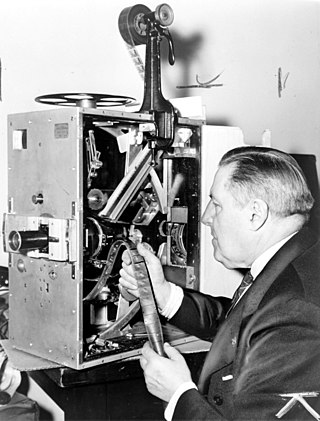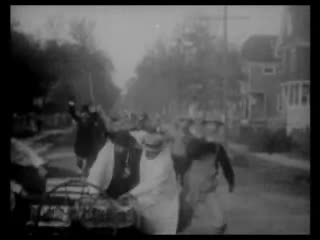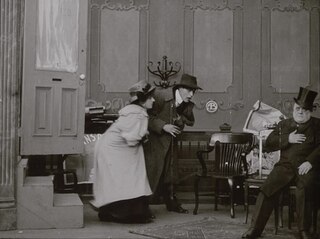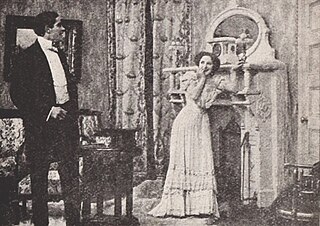
Gottfried Wilhelm Bitzer was an American cinematographer, notable for his close association and pioneering work with D. W. Griffith.

Linda Arvidson was an American stage and film actress. She became one of America's early motion picture stars while working at Biograph Studios in New York, where none of the company's actors, until 1913, were credited on screen. Along with Florence Lawrence, Marion Leonard, and other female performers there, she was often referred to by theatergoers and in trade publications as simply one of the "Biograph girls". Arvidson began working in the new, rapidly expanding film industry after meeting her future husband D. W. Griffith, who impressed her as an innovative screen director. Their marriage was kept secret for reasons of professional discretion.

Herbert Yost was an American actor who in a career that spanned nearly half a century performed predominantly on stage in stock companies and in numerous Broadway productions. Yost also acted in motion pictures, mostly in one-reel silent shorts released by the Biograph Company and Edison Studios between November 1908 and July 1915. By the time he began working in the film industry, Yost already had more than a decade of stage experience in hundreds of dramatic and comedic roles and was widely regarded in the theatre community "as one of the country's finest stock actors". Reportedly, to reduce the risk of tarnishing his reputation as a professional actor by being identified as a screen performer, Yost often billed himself as "Barry O'Moore" while working in films. He was ultimately cast in scores of motion pictures in the early silent era, although with the exceptions of appearing in three more films in the sound era, Yost spent the remaining decades of his career acting in major theatre productions, almost exclusively on Broadway.

The Curtain Pole is a 1909 American comedy film directed by D. W. Griffith. A print of the film still exists. The film was made by the American Mutoscope and Biograph Company when it and many other early film studios in America's first motion picture industry were based in Fort Lee, New Jersey at the beginning of the 20th century.

A Drunkard's Reformation is a 1909 American drama film directed by D. W. Griffith. Prints of the film survive in the film archive of the Library of Congress. The American Mutoscope and Biograph Company advertised the feature as "The most powerful temperance lecture ever depicted".

Stanner E.V. Taylor was an American screenwriter and film director of the silent era. He wrote for more than 100 films between 1908 and 1929.

The Call of the Wild is a 1908 American short silent Western film directed by D. W. Griffith and produced by the American Mutoscope and Biograph Company. The short, a "one-reeler", stars Charles Inslee, Harry Solter and Florence Lawrence. Its interior scenes were shot at Biograph's studio facilities in New York City, and its exteriors were filmed on location in Coytesville, today one of the oldest communities in Fort Lee, New Jersey.

The Maniac Cook is a 1909 American silent thriller film produced by the Biograph Company of New York, directed by D. W. Griffith, and starring Anita Hendrie in the title role. Principal cast members also include Harry Solter and Marion Leonard.

Edgar Allen Poe [sic] is a 1909 American silent drama film produced by the Biograph Company of New York and directed and co-written by D. W. Griffith. Herbert Yost stars in this short as the 19th-century American writer and poet Edgar Allan Poe, while Linda Arvidson portrays Poe's wife Virginia. When it was released in February 1909 and throughout its theatrical run, the film was consistently identified and advertised with Poe's middle name misspelled in its official title, using an "e" instead of the correct second "a". The short was also originally shipped to theaters on a "split reel", which was a single reel that accommodated more than one film. This 450-foot drama shared its reel with another Biograph short, the 558-foot comedy A Wreath in Time. Prints of both films survive.

A Wreath in Time is a 1909 American silent comedy film written and directed by D. W. Griffith, produced by the Biograph Company of New York City, and co-starring Mack Sennett and Florence Lawrence. At its release in February 1909, the short was distributed to theaters on a "split reel", which was a single reel that accommodated more than one film. A Wreath in Time shared its reel with another Biograph short also directed by Griffith, the drama Edgar Allen Poe [sic]. Original paper rolls of contact prints of both motion pictures, as well as safety-stock copies of the two films, are preserved in the Library of Congress.

Her First Biscuits is a 1909 American silent short comedy film written by Frank E. Woods, directed by D. W. Griffith, and starring John R. Cumpson and Florence Lawrence. At its release in June 1909, the comedy was distributed to theaters on a "split reel", which was a single projection reel that accommodated more than one motion picture. It shared its reel with another Biograph short directed by Griffith, the drama The Faded Lilies. Prints of both films are preserved in the film archive of the Library of Congress.

Poisoned Paradise: The Forbidden Story of Monte Carlo is a 1924 American silent romantic drama film directed by Louis Gasnier and starring Kenneth Harlan and Clara Bow. B. P. Schulberg, Bow's new mentor at the time, produced the picture.

A Sound Sleeper is a 1909 American comedy film directed by D. W. Griffith and produced by the American Mutoscope and Biograph Company. The short was filmed in one day in the Coytesville borough of Fort Lee, New Jersey, which at the time was a popular filming location for many early motion-picture studios in the northeastern United States. Due to the brief running time of this comedy, it was originally distributed in April 1909 on a split reel with another Biograph release, a longer dramatic film titled The Winning Coat.

Trying to Get Arrested is a 1909 American comedy short film directed by D. W. Griffith, produced by the Biograph Company of New York City, and starring John R. Cumpson. Filmed in two days in early 1909 at Palisades Park, New Jersey, it was released in April that year and distributed to theaters on a "split reel", which was a single film reel that included more than one motion picture. The other picture that accompanied this comedy was the Biograph "dramedy" The Road to the Heart.

The Road to the Heart is a 1909 American short film, a dramedy directed by D. W. Griffith and produced by the Biograph Company of New York City. Starring David Miles, Anita Hendrie and Herbert Yost, it was filmed over two days in March 1909 at Biograph's studio in Manhattan and released that April in theaters as a film reel split with the Biograph comedy Trying to Get Arrested.

A Rude Hostess is a 1909 American silent film comedy written and directed by D. W. Griffith, produced by the American Mutoscope and Biograph Company in New York City, and co-starring Marion Leonard and Arthur V. Johnson. At its release in April 1909, the short was distributed to theaters on a "split reel", which was a single reel that accommodated more than one film. A Rude Hostess shared its reel with another Biograph comedy short directed by Griffith, Schneider's Anti-Noise Crusade. Original contact-print paper rolls of both motion pictures, as well as projectable safety-stock copies of the films, are preserved in the Library of Congress.

Schneider's Anti-Noise Crusade is a 1909 American silent film comedy written and directed by D. W. Griffith, produced by the American Mutoscope and Biograph Company in New York City, and co-starring John R. Cumpson and Florence Lawrence. At its release in April 1909, the short was distributed to theaters on a "split reel", which was a single reel that accommodated more than one film. This short shared its reel with another Biograph comedy directed by Griffith, A Rude Hostess.

The Medicine Bottle is a 1909 American silent thriller film written and directed by D. W. Griffith, produced by the American Mutoscope and Biograph Company in New York City, and starring Florence Lawrence, Adele DeGarde, and Marion Leonard. At its release in March 1909, the short was distributed to theaters on a "split reel", which was a single projection reel that accommodated more than one film. This drama shared its reel with another Biograph short directed by Griffith, the comedy Jones and His New Neighbors.

Jones and His New Neighbors is a 1909 American silent comedy film written by Frank E. Woods and directed by D. W. Griffith. Produced by the American Mutoscope and Biograph Company in New York City, the short stars John R. Cumpson, Florence Lawrence, and Anita Hendrie. It is one film in a series of 1908 and 1909 Biograph pictures in which Cumpson and Lawrence performed together as the married couple Mr. and Mrs. Jones. When this comedy was released in March 1909, it was distributed to theaters on a "split reel", which was a single projection reel that accommodated more than one motion picture. It shared its reel with another Biograph short directed by Griffith, the dramatic "thriller" The Medicine Bottle.

Jones and the Lady Book Agent is a 1909 American silent comedy film written by Frank E. Woods and directed by D. W. Griffith. Produced by the American Mutoscope and Biograph Company in New York City, the short stars John R. Cumpson, Florence Lawrence, and Flora Finch as the "lady book agent". It is one film in a series of 1908 and 1909 Biograph pictures in which Cumpson and Lawrence performed together as the married couple Mr. and Mrs. Jones. When this comedy was released in May 1909, it was distributed to theaters on a "split reel", which was a single projection reel that accommodated more than one motion picture. It shared its reel with another Biograph comedy short directed by Griffith, The French Duel. The film was released on May 10, 1909 by Biograph Company and was met by positive viewers. The film is presumed lost.




















